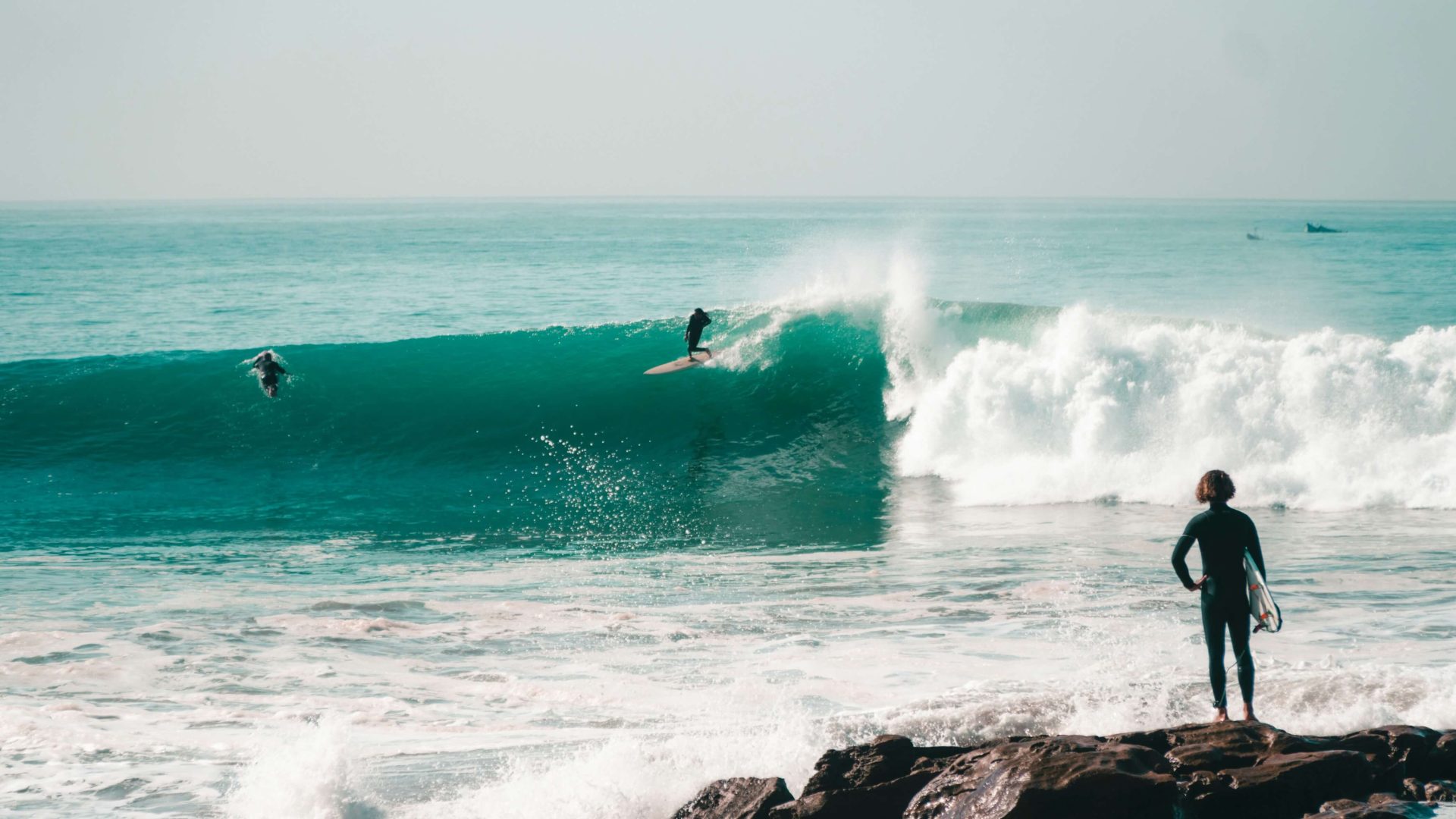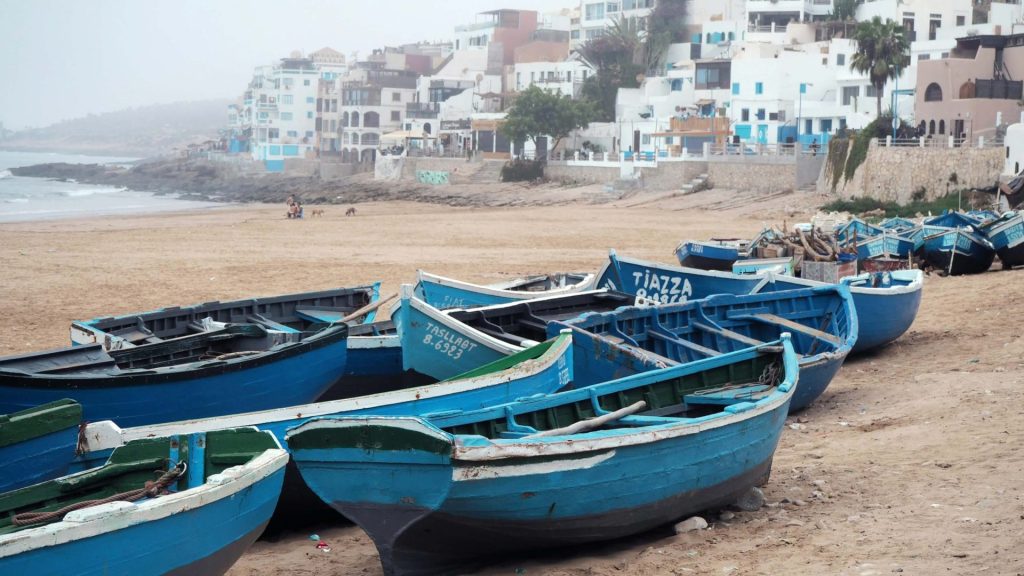Surfing in Morocco Guide 2024

So you want to know about surfing in Morocco? I don't blame you, it's an absolutely stunning country with a thriving surf culture!
This guide to surfing in Morocco will answer any questions you have about surfing or travel surrounding Morocco in 2024!
Where to Surf in Morocco?
Short Answer: Morocco offers fantastic surf spots such as Taghazout, Essaouira, and Agadir, each providing unique waves and a vibrant surf culture.
Morocco Quick Facts
- Continent - Africa
- Population - 37 Million
- Internet - 5Mbps (average)
- Average Trip Length - 21 days
- Power - 115V/230V/50Hz
- Currency - MAD 100 = USD 9.81
- Tap Water - Not Drinkable
- Cashless - No, Cash Only
- Religion - Muslim
- Short Haul Air Carrier - Ryanair
- International Air Carrier - Jet Airways
- Dinner - $4.40
- Beer - $1.56
- Coffee - $0.82
Surfing in Morocco History
From the early days of surfing pioneers testing the Atlantic swells to the establishment of surf clubs, Morocco's surfing history is rich and captivating.
The Surfing Federation of Morocco, founded in 1969, has played a pivotal role in promoting the sport nationally and internationally.
Areas within Morocco
From the iconic waves of Taghazout to the laid-back vibes of Tamraght, surfing in Morocco spans the Atlantic coast, offering a variety of breaks for surfers of all levels.
Explore the bustling city of Agadir and the charming coastal town of Essaouira for diverse surfing experiences.
If you want a break from the surf you can always venture in Marrakech and the Atlas mountains where you have access to the Sahara Desert and much more!
Where To Go Surfing in Morocco Table
| Surf Spot | Wave Quality | Wave Type | Best Season | Difficulty Level | Crowd Level |
|---|---|---|---|---|---|
| Anchor Point | World-class | Point Break | Autumn-Winter | Intermediate-Advanced | High |
| Taghazout Bay | Excellent | Beach Break | All Year | Beginner-Intermediate | Moderate |
| Killer Point | World-class | Point Break | Autumn-Winter | Intermediate-Advanced | High |
| Boilers | Excellent | Reef Break | Autumn-Winter | Intermediate-Advanced | Moderate |
| Banana Point | Very Good | Point Break | Autumn-Winter | Beginner-Intermediate | High |
| Imsouane | World-class | Point Break | Autumn-Winter | Intermediate-Advanced | Moderate |
| Essaouira | Good | Beach Break | All Year | Beginner-Intermediate | Moderate |
| Tamri | Very Good | Beach Break | Autumn-Winter | Beginner-Intermediate | Low |
Best Surf Spots in Morocco
When surfing in Morocco these three spots stand out as the best all year round!
Taghazout
- Details: Taghazout is a surfing mecca, known for spots like Anchor Point and Killer Point.
- Suitable For: All skill levels, with varied breaks catering to different surfers.
Essaouira
- Details: Essaouira offers a relaxed atmosphere and consistent waves.
- Suitable For: All levels, with a variety of beach breaks.
Agadir
- Details: Agadir provides a mix of lively city life and accessible surf spots.
- Suitable For: All levels, with diverse breaks along the coast.
Best Spots for Beginners Surfing in Morocco
Taghazout's Banana Beach
Nestled along the enchanting Taghazout Bay, Banana Beach stands out as an idyllic haven for beginner surfers.
With its gently rolling waves, this coastal gem provides an ideal setting for novices to hone their skills.
Numerous surf schools dotting the shoreline offer patient instructors and quality equipment, ensuring a supportive and safe environment for those taking their first strokes into the world of surfing.
Tamraght's Devil's Rock
For beginners seeking a welcoming surf locale, Devil's Rock in Tamraght is a picture-perfect choice.
Known for its consistent, mellow waves, this beach break is conducive to learning and progression.
Surf schools in the vicinity not only provide expert guidance but also create a friendly atmosphere where beginners can build confidence and relish the joy of riding the Moroccan waves.
Directions for Best Surfing in Morocco
To embark on a surfing adventure along Morocco's diverse coastline, follow these directions for reaching some of the most renowned surf spots:
Agadir: Take the N1 road southward from Agadir, where you'll discover a myriad of surf spots catering to various skill levels. From the lively city, explore breaks like Taghazout, Anchor Point, and Tamraght for a taste of Morocco's vibrant surf culture.
Taghazout: Head north from Agadir on the N1 to reach Taghazout, the heart of Moroccan surfing. Renowned for its world-class waves, Taghazout offers an array of breaks such as Banana Beach and Anchor Point, providing surfers with diverse options for every level.
Average Wave Height in Morocco
Wave heights off Morocco's coast exhibit seasonal variations, influencing the surfing experience:
Winter Months (November to February): Experienced surfers are drawn to Morocco during winter especially in December, as powerful Atlantic swells create waves ranging from 6 to 15 feet. The challenging conditions contribute to the allure of spots like Anchor Point, providing an exhilarating experience for those with advanced skills.
Summer Months (June to August): Summer ushers in smaller, beginner-friendly waves, typically ranging from 2 to 6 feet. Coastal gems like Banana Beach become ideal playgrounds for novices, offering a more gentle introduction to the art of surfing.
Best Time For Surfing in Morocco
Spring (March to May): Spring in Morocco brings a harmonious blend of consistent swells and comfortable weather, making it an ideal season for surfers of all levels. Explore breaks like Taghazout and Tamraght to enjoy the balance between wave quality and pleasant conditions.
Summer (June to August): With smaller waves and warmer temperatures, summer caters to beginners seeking a relaxed introduction to surfing. Coastal spots like Banana Beach become popular among novices, offering an inviting environment to catch the summer waves.
Autumn (September to November): Autumn signals the arrival of larger swells, attracting experienced surfers to Morocco's coast. Surfing hotspots like Anchor Point come alive with challenging waves, providing a thrilling experience for those seeking more advanced conditions.
Winter (December to February): Winter is favored by experienced surfers as powerful Atlantic swells grace the Moroccan shores. While the waves are impressive, the colder temperatures and stormy conditions demand advanced skills and suitable equipment for a safe and enjoyable surfing experience.
Climate When Surfing in Morocco
Morocco's temperate maritime climate plays a significant role in shaping the surfing experience:
Winters (December to February) bring relatively cool temperatures, averaging between 12 to 20°C (54 to 68°F).
Summers (June to August) offer milder conditions, with temperatures ranging from 20 to 30°C (68 to 86°F).
Given the variability, surfers are advised to pack layers and waterproof gear to adapt to the ever-changing weather conditions along Morocco's picturesque coastline.
Surfing in Morocco Need to Know
Morocco Surf Crowds
Surf crowds in Morocco vary by location and time of year. Popular spots like Taghazout and Anchor Point may experience increased surfers, especially during the summer.
However, compared to global surfing hotspots, Morocco's coast often provides a more relaxed and uncrowded experience, especially in less frequented areas, allowing surfers to savor the beauty of the Atlantic waves in a serene environment.
Morocco Surf Hazards
Surfing in Morocco comes with its set of hazards, including powerful Atlantic swells during the winter months that can create challenging conditions.
Cold water temperatures throughout the year necessitate the use of appropriate wetsuits and gear to prevent hypothermia.
Additionally, rocky coastlines and submerged obstacles in certain areas pose potential dangers, emphasizing the importance of local knowledge and caution while navigating the diverse surf spots in Morocco.
Morocco Surf Pollution
While Morocco's surf zones are generally pristine, surfers should be mindful of potential pollution risks.
Runoff from urban areas, agricultural activities, and litter can contribute to water pollution along the coastline.
Staying informed about local water quality conditions and supporting conservation efforts ensures a cleaner and safer surfing experience for both locals and visitors.
Morocco Surf Camps

Culture in Morocco
Respecting Local Customs: Immerse yourself in Moroccan culture by respecting local customs. Greetings are important, modesty is valued, and taking off shoes when entering homes is customary.
Trying Traditional Cuisine: Savor the flavors of Morocco with traditional dishes like tagines and couscous. Explore local markets for fresh produce and try street food delicacies.
Embracing Hospitality: Engage with locals, share a cup of tea, and be open to cultural exchanges. Moroccans are known for their warm hospitality, so embrace the opportunity to connect with the local community.
Familiarizing with Cultural Norms: Understand cultural norms, like avoiding public displays of affection, especially in conservative areas. Learning and respecting these nuances contribute to a positive interaction with locals.
Enjoying the Vibrant Atmosphere: Explore lively medinas, participate in local festivities, and attend traditional music and dance performances. Immerse yourself in the rich cultural tapestry of Morocco.
Food in Morocco
Savoring Traditional Moroccan Dishes: Indulge in tagines, couscous, and aromatic mint tea. Don't miss out on the diverse array of pastries and sweets that Moroccan cuisine has to offer.
Exploring Local Markets: Wander through the markets to discover fresh fruits, vegetables, spices, and aromatic herbs. Engage with local vendors and experience the vibrant energy of these bustling marketplaces.
Trying Street Food Delicacies: Venture beyond restaurants to sample authentic street food. From savory snacks to sweet treats, Moroccan street vendors offer a variety of flavorful options.
Packing Snacks for Surf Adventures: Pack convenient snacks like nuts, dried fruits, and energy bars for surf breaks. Staying hydrated is essential, so carry a reusable water bottle.
Frequently Asked Questions
Is Morocco a suitable destination for beginner surfers?
Yes, Morocco is an excellent destination for beginners. Spots like Tamri offer gentle waves ideal for those learning to surf, and surf camps in Taghazout often provide lessons and equipment rental for novices.
Are there surf shops and rental facilities when surfing in Morocco?
Yes, you'll find surf shops and rental facilities in popular surf destinations like Taghazout and Agadir. They offer a range of surfboards and equipment for all levels of surfers.
What's the water temperature like surfing in Morocco?
The water temperature in Morocco varies throughout the year. In the winter, it can drop to around 16-18°C (61-64°F), so wearing a wetsuit is recommended. In the summer, temperatures can rise to 20-23°C (68-73°F), making it more comfortable for shorties or boardshorts.
What's the best time of year for surfing in Morocco?
The best time for surfing in Morocco is during the fall and winter months, from September to April. This period offers consistent swells and offshore winds, creating ideal conditions for surfers.
Is it surfing in Morocco safe for females?
Morocco is generally safe for surfers, including female surfers. However, it's advisable to respect local customs and dress modestly when outside of the surf zones, especially in more conservative areas.
Are there any cultural considerations when surfing in Morocco?
Yes, it's important to be respectful of local customs and traditions. Covering up outside the beach areas is advisable, and always ask for permission before taking photos of local people or their property. Showing respect for the local culture enhances your experience in Morocco.


